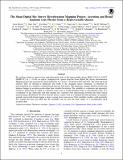Files in this item
The Sloan Digital Sky Survey Reverberation Mapping Project : accretion and broad emission line physics from a hypervariable quasar
Item metadata
| dc.contributor.author | Dexter, Jason | |
| dc.contributor.author | Xin, Shuo | |
| dc.contributor.author | Shen, Yue | |
| dc.contributor.author | Grier, C. J. | |
| dc.contributor.author | Liu, Teng | |
| dc.contributor.author | Gezari, Suvi | |
| dc.contributor.author | McGreer, Ian D. | |
| dc.contributor.author | Brandt, W. N. | |
| dc.contributor.author | Hall, P. B. | |
| dc.contributor.author | Horne, Keith | |
| dc.contributor.author | Simm, Torben | |
| dc.contributor.author | Merloni, Andrea | |
| dc.contributor.author | Green, Paul J. | |
| dc.contributor.author | Vivek, M. | |
| dc.contributor.author | Trump, Jonathan R. | |
| dc.contributor.author | Homayouni, Yasaman | |
| dc.contributor.author | Peterson, B. M. | |
| dc.contributor.author | Schneider, Donald P. | |
| dc.contributor.author | Kinemuchi, K. | |
| dc.contributor.author | Pan, Kaike | |
| dc.contributor.author | Bizyaev, Dmitry | |
| dc.date.accessioned | 2019-12-10T16:30:03Z | |
| dc.date.available | 2019-12-10T16:30:03Z | |
| dc.date.issued | 2019-11-01 | |
| dc.identifier | 262820952 | |
| dc.identifier | 75cd3dd6-700e-441f-8e15-8348cf986852 | |
| dc.identifier | 85075229661 | |
| dc.identifier | 000498546800014 | |
| dc.identifier.citation | Dexter , J , Xin , S , Shen , Y , Grier , C J , Liu , T , Gezari , S , McGreer , I D , Brandt , W N , Hall , P B , Horne , K , Simm , T , Merloni , A , Green , P J , Vivek , M , Trump , J R , Homayouni , Y , Peterson , B M , Schneider , D P , Kinemuchi , K , Pan , K & Bizyaev , D 2019 , ' The Sloan Digital Sky Survey Reverberation Mapping Project : accretion and broad emission line physics from a hypervariable quasar ' , Astrophysical Journal , vol. 885 , no. 1 , 44 , pp. 1-11 . https://doi.org/10.3847/1538-4357/ab4354 | en |
| dc.identifier.issn | 0004-637X | |
| dc.identifier.other | crossref: 10.3847/1538-4357/ab4354 | |
| dc.identifier.uri | https://hdl.handle.net/10023/19113 | |
| dc.description | Funding: UK STFC grant ST/R000824/1 (K.H.). | en |
| dc.description.abstract | We analyze extensive spectroscopic and photometric data of the hypervariable quasar SDSS J141324+530527 (RMID 017) at z = 0.456, an optical "changing-look" quasar from the Sloan Digital Sky Survey Reverberation Mapping project that increased in optical luminosity by a factor ≅10 between 2014 and 2017. The observed broad emission lines all respond in luminosity and width to the changing optical continuum, as expected for photoionization in a stratified, virialized broad emission line region. The luminosity changes therefore result from intrinsic changes in accretion power rather than variable obscuration. The variability is continuous and apparently stochastic, disfavoring an origin as a discrete event such as a tidal disruption flare or microlensing event. It is coordinated on day timescales with blue leading red, consistent with reprocessing powering the entire optical spectral energy distribution. We show that this process cannot work in a standard thin disk geometry on energetic grounds, and would instead require a large covering factor reprocessor. Disk instability models could potentially also explain the data, provided that the instability sets in near the inner radius of a geometrically thick accretion disk. | |
| dc.format.extent | 11 | |
| dc.format.extent | 1478635 | |
| dc.language.iso | eng | |
| dc.relation.ispartof | Astrophysical Journal | en |
| dc.subject | QB Astronomy | en |
| dc.subject | QC Physics | en |
| dc.subject | NDAS | en |
| dc.subject.lcc | QB | en |
| dc.subject.lcc | QC | en |
| dc.title | The Sloan Digital Sky Survey Reverberation Mapping Project : accretion and broad emission line physics from a hypervariable quasar | en |
| dc.type | Journal article | en |
| dc.contributor.sponsor | Science & Technology Facilities Council | en |
| dc.contributor.institution | University of St Andrews. School of Physics and Astronomy | en |
| dc.contributor.institution | University of St Andrews. St Andrews Centre for Exoplanet Science | en |
| dc.identifier.doi | https://doi.org/10.3847/1538-4357/ab4354 | |
| dc.description.status | Peer reviewed | en |
| dc.identifier.grantnumber | ST/R00824/1 | en |
This item appears in the following Collection(s)
Items in the St Andrews Research Repository are protected by copyright, with all rights reserved, unless otherwise indicated.

